- Afrikaans
- Albanian
- Amharic
- Arabic
- Armenian
- Azerbaijani
- Basque
- Belarusian
- Bengali
- Bosnian
- Bulgarian
- Catalan
- Cebuano
- Corsican
- Croatian
- Czech
- Danish
- Dutch
- English
- Esperanto
- Estonian
- Finnish
- French
- Frisian
- Galician
- Georgian
- German
- Greek
- Gujarati
- Haitian Creole
- hausa
- hawaiian
- Hebrew
- Hindi
- Miao
- Hungarian
- Icelandic
- igbo
- Indonesian
- irish
- Italian
- Japanese
- Javanese
- Kannada
- kazakh
- Khmer
- Rwandese
- Korean
- Kurdish
- Kyrgyz
- Lao
- Latin
- Latvian
- Lithuanian
- Luxembourgish
- Macedonian
- Malgashi
- Malay
- Malayalam
- Maltese
- Maori
- Marathi
- Mongolian
- Myanmar
- Nepali
- Norwegian
- Norwegian
- Occitan
- Pashto
- Persian
- Polish
- Portuguese
- Punjabi
- Romanian
- Russian
- Samoan
- Scottish Gaelic
- Serbian
- Sesotho
- Shona
- Sindhi
- Sinhala
- Slovak
- Slovenian
- Somali
- Spanish
- Sundanese
- Swahili
- Swedish
- Tagalog
- Tajik
- Tamil
- Tatar
- Telugu
- Thai
- Turkish
- Turkmen
- Ukrainian
- Urdu
- Uighur
- Uzbek
- Vietnamese
- Welsh
- Bantu
- Yiddish
- Yoruba
- Zulu
کانونی یەکەم . 25, 2024 09:10 Back to list
Injection Locations for Ivermectin in Swine Management and Care
Where to Inject Ivermectin in Pigs A Comprehensive Guide
Ivermectin is a widely used antiparasitic medication in veterinary medicine, particularly for treating various parasitic infections in livestock such as pigs. Ensuring that ivermectin is administered correctly is crucial for maximizing its efficacy and ensuring the health and welfare of the animals. This article will discuss the best practices for administering ivermectin to pigs, focusing on the preferred injection sites, dosages, and considerations to keep in mind.
Understanding Ivermectin
Ivermectin is effective against a variety of parasites, including internal parasites (like roundworms and lungworms) and external parasites (such as mites and lice). It works by disrupting the nervous system of the parasites, leading to their paralysis and eventual death. However, to achieve the best results, it is important to administer the drug properly.
Preferred Injection Sites
When injecting ivermectin in pigs, the choice of injection site is critical. The most commonly recommended sites are
1. Neck Region The lateral aspect of the neck is often the preferred site for intramuscular (IM) injections. This area provides sufficient muscle mass and is easy to access. To ensure proper administration, inject into the muscle just below the skin, avoiding blood vessels and nerves.
2. Shoulder Muscle Another suitable site for IM injections is the shoulder muscle. Similar to the neck, the shoulder area is safe and has enough muscle to accommodate the injection.
3. Subcutaneous Administration Ivermectin can also be administered subcutaneously (under the skin) in pigs. The most common site for subcutaneous injection is the loose skin behind the ear. This method is often used when a larger volume of fluid needs to be administered, as it allows for slower absorption and less stress on the animal.
where to inject ivermectin in pigs

4. Avoiding Certain Areas It is essential to avoid injecting into areas with a high density of blood vessels, such as the spinal column or areas over the hindquarters, to prevent potential complications.
Dosage Guidelines
The appropriate dosage of ivermectin depends on the specific weight of the pig and the type of infection being treated. The standard dosage in pigs is generally 0.2 mg/kg body weight when administered either subcutaneously or intramuscularly. It is crucial to weigh the animals accurately to ensure the correct dosage is given. Overdosing can lead to toxicity, while underdosing may result in ineffective treatment and continued parasitic infections.
Safety Precautions
When administering ivermectin, several safety precautions should be considered
- Sterile Technique Always use sterile needles and syringes to prevent infections. After each injection, dispose of needles properly to avoid any risk of injury. - Handling and Restraint Ensure pigs are handled properly and restrained to minimize stress during the injection process. This not only protects the animal but also the handler from potential injuries.
- Observation After administering ivermectin, monitor the pigs for any adverse reactions. While allergic reactions are rare, it is vital to be alert for signs of distress or unusual behaviors.
Conclusion
Injecting ivermectin in pigs is a vital component of effective parasite management within swine production. Selecting the appropriate injection site, adhering to dosage recommendations, and practicing proper safety protocols will not only ensure the health of the pigs but also promote better welfare and productivity in the herd. Owners and veterinarians should work closely together to develop and implement effective health management plans that include the responsible use of antiparasitic treatments like ivermectin. Always consult a veterinarian if you have any questions or concerns regarding the use of this medication in your livestock.
-
Guide to Oxytetracycline Injection
NewsMar.27,2025
-
Guide to Colistin Sulphate
NewsMar.27,2025
-
Gentamicin Sulfate: Uses, Price, And Key Information
NewsMar.27,2025
-
Enrofloxacin Injection: Uses, Price, And Supplier Information
NewsMar.27,2025
-
Dexamethasone Sodium Phosphate Injection: Uses, Price, And Key Information
NewsMar.27,2025
-
Albendazole Tablet: Uses, Dosage, Cost, And Key Information
NewsMar.27,2025













